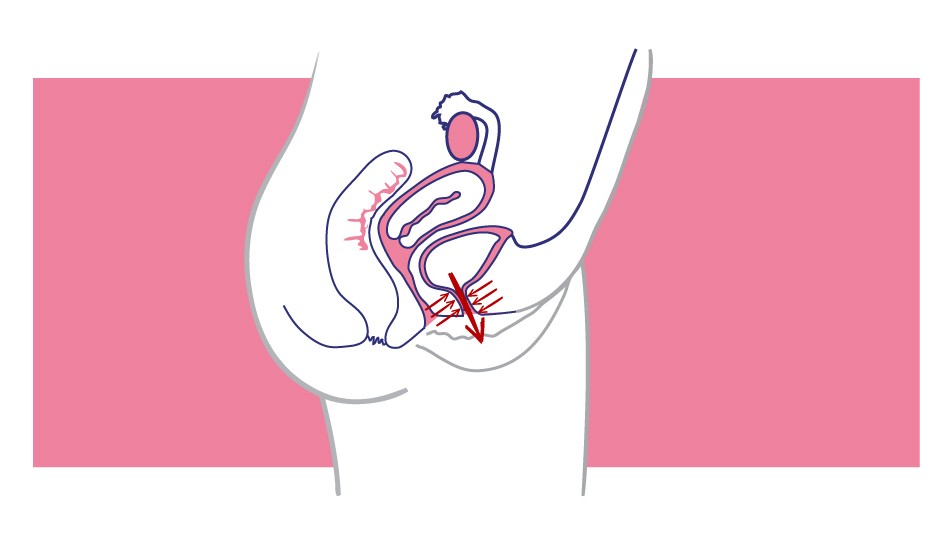Urinary Incontinence
What are the different types of urinary incontinence?
Stress urinary incontinence (SUI): involuntary loss of urine when pressure on the abdomen increases due to physical activity or effort.
This consists of the involuntary loss of urine due to effort, exercise, sneezing or coughing. Incontinence occurs when pressure inside the urethra is greater than that in the bladder. The underlying cause may reside in the hypermobility of the neck of the bladder and the urethra because it lacks extrinsic support (vagina and pelvic floor). Stress urinary incontinence (SUI) may also be due to an intrinsic defect of the urethral sphincter as a result of neuromuscular problems.
Urge urinary incontinence (UUI): involuntary loss of urine associated with a sudden and uncontrollable urge to urinate. It is often accompanied by an increase of frequency both during the day or at night. Also known as hyperactive bladder.
Mixed urinary incontinence (MUI): a symptomatic combination of stress incontinence (SUI) and hyperactive bladder.
Overflow incontinence: when the bladder does not empty completely, either because of obstruction or because the bladder muscle does not contract properly, causing loss of urine when the bladder is full.
Others: anomalies in the urinary tract, neurological disorders, infection, inflammation, foreign bodies, stones, etc..
What is the prevalence of urinary incontinence in women?
It is difficult to determine exactly. It is a problem that increases with age, many people regard it as normal and do not consult their doctor about it, and thus statistics are highly variable.
What group is most affected by urinary incontinence?
From the age of 40, between 14% and 35% of women experience urinary incontinence. This frequency peaks between the ages of 50 and 60 years. From the age of 60, urge incontinence and mixed types increase, while stress incontinence decreases.
Why is it important to distinguish between stress urinary incontinence and urge urinary incontinence?
It is very important because the treatment is different in each case, ranging from pysiotherapy to bio-feedback, electro-stimulation, medical treatment or surgery.
What is urinogynecology?
Urinogynecology is a sub-speciality of obstetrics and gynecology for the diagnosis and treatment of pelvic floor disorders. It covers frequent cases such as urinary incontinence and prolapse of the pelvic organs, but is in fact more complicated; it also includes fecal incontinence, bladder evacuation disorders, difficulty in defecation, sexual disfunction and chronic pain. It must therefore be treated conjointly and from a comprehensive and integral point of view.
What is the pelvic floor?
The pelvic floor is all the muscles, ligaments, connective tissue and nerves that support and control the uterus, vagina, bladder, urethra and rectum.
What are the symptoms of pelvic floor disorder?
Urinary incontinence: involuntary loss of urine.
Loss of control of stool and discharge of gases.
Genital prolapse: a condition in which the pelvic organs descend from their normal anatomical position towards the vagina, with the feeling of a “lump” at the level of the external genitalia.
Pelvic pain, soreness or pain in the bladder or urethra.
Disorder or discomfort in sexual relations.
What is the pelvic floor rehabilitation or physiotherapy?
They are exercises to improve elasticity and muscular strength, to strengthen closure of the urethra and prevent urine loss. The aim is to tone up the muscles of the pelvis, maintain muscular contraction and increase the number of repetitions, and they are known as Kegel exercises. They can be combined with the use of vaginal cones.
What does surgery for urinary incontinence involve?
There are two approaches:
Transvaginal surgery: by means of Tension-free Vaginal Tape, TOT, cystorraphy… It is performed in cases of SUI or mixed type incontinence in which no other disorder of the pelvic floor is involved. It is a quick and simple operation performed with general anaesthetic and leads to rapid recovery with satisfactory results. This type of operation is favourably received by patients, even those of more mature years.
Laparoscopic surgery: when urinary incontinence is associated with uterine prolapse, the most frequently employed technique is the Burch operation (retropubic colposuspension), since with laparoscopy other procedures for reestablishing the normal support for genital structures can also be used at the same time, such as colposacropexis with tension-free tape.
What are the advantages of surgery by laparoscopy?
A more direct view of the deeper areas of the pelvis is achieved, with easier access to anatomical spaces which are difficult to reach with other types of surgery. This provides better identification and analysis of the support defects, so that sutures are far more precise and effective than with traditional surgery. Blood loss during the operation is much less; post-operative pain is also reduced, with less need for medication; scarring is almost negligible; time spent in hospital is less; recovery is quicker, and the patient can return to work much earlier.

